Macro on the cheap - which way is better?
Feb 10, 2018 13:42:47 #
latebloomer
Loc: Topeka, KS
dpullum wrote:
Your question, A or B. Perhaps the better question is not OR, rather AND/OR.... Neither/Nor does not logically apply here. For very well presented information combining a 100mm Macro with Extension Tubes Google the following: [sorry URL was copy blocked]
GOOGLE: An Exercise in Magnification with Extension Tubes • Martin Bailey
This site has charts and photo examples of a mm scale demonstrating the clarity and magnification.
GOOGLE: An Exercise in Magnification with Extension Tubes • Martin Bailey
This site has charts and photo examples of a mm scale demonstrating the clarity and magnification.
Thank you!! The best clear explanation of the effects of extension tubes I have seen and use.
Feb 10, 2018 13:44:11 #
amfoto1
Loc: San Jose, Calif. USA
bellgamin wrote:
I want to experiment with macro a bit, so I want to do it on the cheap. I have read of 2 el cheapo methods:
1) extension tubes
2) macro filters (you know, those +1 +4 +10 sets - what is the correct name of them I wonder)
Which is better, 1 or 2?
Oh yes, just remembered --- focusing rails ... I assume they will attach to any standard tripod screw-it-on gizmo. Correct?
1) extension tubes
2) macro filters (you know, those +1 +4 +10 sets - what is the correct name of them I wonder)
Which is better, 1 or 2?
Oh yes, just remembered --- focusing rails ... I assume they will attach to any standard tripod screw-it-on gizmo. Correct?
I prefer extension tubes. They are versatile and will work well with many different lenses.
Don't get too cheap with them, though. The "dumb" tubes under $25 have no electronic contacts, which most lenses require these days to be able to autofocus and, even more importantly, control the aperture. Plan to spend roughly $50 to $110 for the type of extension tubes that have electronic contacts. "Budget" ones from Zeikos that are mostly plastic (even the bayonet mounts) are the cheapest. Those sell under a bunch of different brand names. In the middle are somewhat better with metal bayonet mounts, from Zeikos and Opteka (both selling under other brand names). At the higher end is the Kenko set, which are pretty much equal to the quality of OEM from the camera makers themselves (who also sell tubes, though usually only individually and VERY overpriced).
Close-up "filters" also range from cheapies to decent quality "diopters". The $25 sets with +1, +2 etc. are awful, uncoated glass that make crappy images. There are much better quality, such as Canon's 500D and 250D which are multi-element... but with those you buy one to fit a specific lens, which may or may not fit and work on your other lenses. One high quality diopter in a fairly large diameter such as 72mm or 77mm will cost about the same or more than the Kenko tube set, too.
Focusing rails DO NOT do anything to make close-up/macro possible, the way diopters and extension tubes do. Focusing rails are an accessory to help with precise manual focusing at high magnifications.
Some focusing rails are incorporated into or an accessory to macro "bellows" assemblies. Bellows are essentially just variable length, extra long extension tubes that are usually used for very high magnification work. Bulky, easy to damage with mishandling and "dumb" (no electronic contacts), or very expensive (with electronic contacts), bellows are not something I'd recommend to someone just getting into macro & close-up photography.
A "true" modern, macro capable lens certainly is the easiest way to do macro and close-up work. Vintage macro lenses also might work pretty well and, depending upon your system, you might be surprised what's available and find some bargains in the used market.
An example, I bought a Tamron SP 90mm f/2.5 Macro lens at a local second-hand store for $20. Dating from the 1980s (though apparently little used, looks like new), it's a manual focus lens that uses interchangeable mounts. It came with a Nikon F-mount and I already had Adaptall2 mounts for several other systems, but not for my main Canon DSLR user system. So it cost me another $40 to get an Adaptall2 from China for the lens. For a total of $60, I've got a really nice, capable macro lens, although on it's on it is only able to do 1:2 magnification. No problem, though, if you have extension tubes. Below was shot with that lens and a 20mm (Kenko) or 25mm (Canon) extension tube, to increase the lens' magnification greater than 1:2...

Below are a couple poppy buds shot without the extension tube (left) and with it (right)...
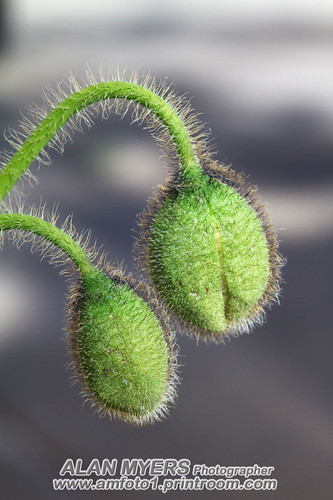
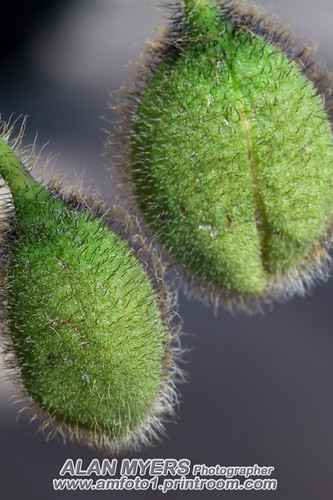
Here's the Tamron SP 90mm mounted on one of my cameras (left) and the lens alone with EOS-EF Adaptall2 interchangeable mount installed and a Nikon F Adaptall2 alongside (right)...
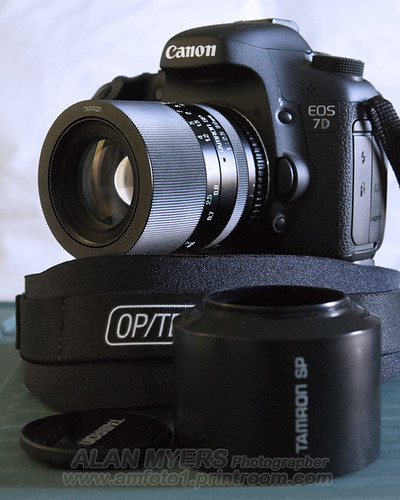
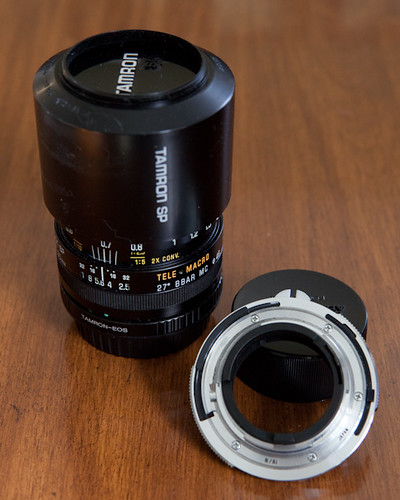
I've used several of the Tamron 90mm over the years with various film camera systems, so I knew it's capabilities and didn't hesitate when I saw one available cheap. It's also relatively compact, doesn't occupy a lot of space in my camera bag. There are probably millions of great old macro lenses out there, that might be easily adapted for use on many of today's DSLRs. In part, it depends on the system you use: Canon and Sony can use many other mounts via relatively inexpensive adapters... Nikon, Pentax and some Olympus can accommodate their own vintage, manual focus lenses, but not many other systems. Mirrorless from those and other manufacturers might even be more versatile with adapted lenses, if that's what you're using.
Now, a vintage manual focus & manual aperture lens such as above is not fast to work with.... Shooting a fast moving subject like the bee on the flower above was challenging! (I took probably 75 shots to get 2 or 3 that were well focused and nicely composed). A modern lens with AF and direct aperture control (hence all types of auto exposure) is bound to be quicker to use... that can either be lenses you have now and use with extension tubes or a diopter... or a "true" macro lens. Depending upon what system you use, there may be deals on those, too... either used or new. For example, I bought a modern Tamron 60mm f/2 Di II (crop only) Macro/Portrait lens a few years ago, on sale for $400. That's another compact, versatile lens I'll often tuck into my camera bag. Whether or not that's "cheap" is up to individual interpretation, though. Another example, Tokina makes a nice AT-X Pro 100mm f/2.8 macro lens that's on sale for $350 to $370 right now (the Nikon version is cheaper because it doesn't have a built in focusing motor, so can only autofocus on D7000-series and higher models).
For one's first macro lens, I recommend something in the 90mm, 100mm, 105mm focal length range (on both crop & full frame cameras). That's a good compromise for most people... hand-holdable (with care), but still offering reasonable working distance (about 12" MFD at max magnification, if memory serves). Shorter focal lengths (especially 50mm and less) significantly reduce working distance, which can be a problem with some types of subjects..... Longer focal lengths (150, 180, 200mm) give more working distance, but tend to be a lot more difficult to maintain steady for a sharp shot, more likely to require a tripod a lot of the time.
But if you don't want to spend the money for a true macro lens and don't find any vintage bargains, I'd recommend the middle to better grade extension tubes for use with lenses you already have. I have always carried a few of them in my camera bag, just in case, since experimenting with them and learning to use them around 25 years ago. I've used them with lenses from 20mm to 500mm, though most often with focal lengths in the 50mm to 135mm range. The longer the lens focal length, the more extension needed to significantly increase magnification.... and conversely, using even a very short tube on a wide angle lens puts you extremely close to subjects. In fact, shooting flowers with 12mm extension on a 20mm lens, petals that were touching the front element of the lens were in focus!
There are some alternative methods of shooting macro "on the cheap", depending upon what system you use. Some lenses can be modified pretty easily (I recall removing the front element from certain Canon EF zoom lens(es) can work). Or, in some cases it's possible to "reverse" a lens (might not be able to control the aperture, though, as well as lose autofocus). "Reverse stacking" is yet another way that may be possible, if you happen to have or get the right two lenses to work together. This involves reversing a second lens in front of a normally mounted lens, to act as sort of a high quality diopter (usually will maintain aperture control and AF). In the past I've done this with a 28mm 35mm lens reverse mounted to the front of an 100mm or 135mm lens. One requirement is that the two lenses have the same or close to the same filter thread size... and it might take some experimentation to find a combo that works well and gives the magnification you want (which will be pretty high magnification, usually).
Hope this helps!
Feb 10, 2018 13:54:50 #
JoeJas
Loc: Nazareth, PA (18064)
Good extension tubes , shop around you might find someone selling their old ones.
If you have a old 35 mm and lense use a reversing ring you can get fantastic macro shots.
If you have a old 35 mm and lense use a reversing ring you can get fantastic macro shots.
Feb 10, 2018 14:48:40 #
amfoto1 wrote:
...Close-up "filters" also range from ch... (show quote)
So is there a problem with step up rings with say a 77mm high quality Canon 500D on a 67mm thread lens?
Feb 10, 2018 15:11:48 #
So, what's wrong with this image - apart from many things - as it relates to the discussion about lenses, extension tubes, and close up lenses?
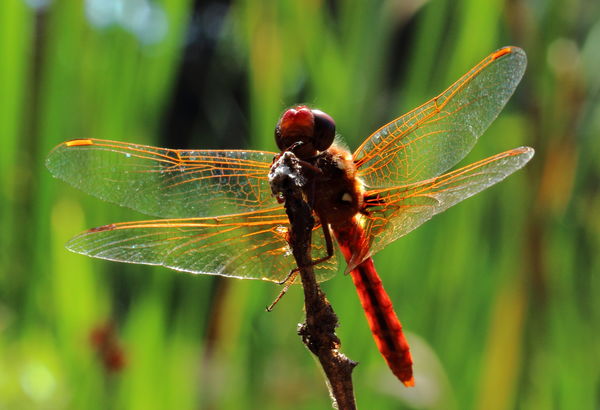
Feb 10, 2018 15:14:57 #
Peterff wrote:
That does depend on the quality of the diopter lenses..., it is not a global truth.
Still if I had a choice between a quality diopter lens or extension tubes (due to limited budget I presume), I would go for the latter. But also, extension tubes vary in quality too, and some don't couple the AF/AE lens information (no contacts), or have bad fit, so I think it's best not to go too cheap on either. With digital photography experiment with both! Also with the diopter lens you often have to stack lenses to get really high magnification - more glass! With tubes (or bellow$$$), you are just creating more airspace.
I guess I am spoiled now with a dedicated macro lens.
Feb 10, 2018 15:28:02 #
chrisg-optical wrote:
Still if I had a choice between a quality diopter ... (show quote)
Sir, I do not disagree. I'm simply asking questions and making a few observations. I use Canon, have a Canon Macro lens, Canon extension tubes, and Canon 250D and 500D diopter lenses. I spent the money on them because I felt it was worth the investment. I also have a Canon ring flash. That all adds up to a chunk of change. Whether I can use them effectively or not is a very different discussion.
Either way I have all of those options available to me. So I may be more spoiled than you are. However, none of that helps a guy who wants to experiment with a limited budget.
Feb 10, 2018 17:21:58 #
bellgamin
Loc: Ewa Beach, Hawaii
@ gvarner-- great link!. I shall add that to my list of things to study into.
@ amfoto1-- I did a copy&paste of your post, into my reference files. Grrrreat!!! 10Q to the nth.
@ Peterff-- I like your dragonfly shot. When I was a kid in Louisiana, I was friends with several dragonflies. In the evening, I could elevate my hand, with index finger extended, & a dragonfly would quickly arrive & land on my finger. I liked the feel of his legs on my finger. Then I brought him down level with my face so I could look him over... especially his complex eyes. Beautiful, friendly, & useful creatures (they eat mosquitos.. hence they are also called mosquito hawks.) True story. I live in Hawaii now. Very rare to see a dragonfly, sad to say.
In yesterday's hunt, in those cases where I had sufficient data provided by the seller, either the lens was incompatible or it was way over my budget or the condition was ap-cray. I also noticed that a majority of listings by real camera stores (rather than mom & pop stores) gave the impression that their condition statements were written by teams of lawyers instead of friendly, helpful photog folks.
I shall try again in a few days. .....Yes, I have a very good tripod. It is steady & reliable. Also, it makes a splendid defensive weapon when confronted by rabid dogs, Yeti, or grifters. 😁
@ amfoto1-- I did a copy&paste of your post, into my reference files. Grrrreat!!! 10Q to the nth.
@ Peterff-- I like your dragonfly shot. When I was a kid in Louisiana, I was friends with several dragonflies. In the evening, I could elevate my hand, with index finger extended, & a dragonfly would quickly arrive & land on my finger. I liked the feel of his legs on my finger. Then I brought him down level with my face so I could look him over... especially his complex eyes. Beautiful, friendly, & useful creatures (they eat mosquitos.. hence they are also called mosquito hawks.) True story. I live in Hawaii now. Very rare to see a dragonfly, sad to say.
Steamboat wrote:
Yesterday I spent 5 hours on the hunt for a non-zoom macro lens within my budget of $150. The hunt was constrained by 2 factors: 1) the lens has to shake hands with my camera, & 2) the seller needs to provide data about the lens he is selling such as ai or non-ai, af, type d or g or ??, & detailed info about condition -- not just comments such as "looks great" or "took it to a photo shop and they said it is really excellent." Also the seller's rating should be = or > 99.7. Also, seller's line of goods sold should include lots of photo equipment instead of being predominated by shoes, gadgets, clothing, etc. I shop a lot on ebay & I adhere to a strict set of guidelines; in result I have yet to buy a lemon whereas I have snagged more than a few peaches -- not because of my own genius but because I sought experienced advisors to teach me the do's & don'ts.I'd get a cheap used macro lens this is your best choice. Easier to use a great place to start and more fun.
1) extension tubes .........They are sharper
This assumes you would be buying cheap close up lenses?
....nothing worse than a cheap close up lens.
Do you have a tripod?
1) extension tubes .........They are sharper
This assumes you would be buying cheap close up lenses?
....nothing worse than a cheap close up lens.
Do you have a tripod?
In yesterday's hunt, in those cases where I had sufficient data provided by the seller, either the lens was incompatible or it was way over my budget or the condition was ap-cray. I also noticed that a majority of listings by real camera stores (rather than mom & pop stores) gave the impression that their condition statements were written by teams of lawyers instead of friendly, helpful photog folks.
I shall try again in a few days. .....Yes, I have a very good tripod. It is steady & reliable. Also, it makes a splendid defensive weapon when confronted by rabid dogs, Yeti, or grifters. 😁
Feb 10, 2018 17:44:29 #
Manual extension tubes combined with an adapter to reverse mount your lens via the filter thread. This will give you better quality close ups.
Feb 10, 2018 19:01:50 #
I have been experimenting with "macro on the cheep" for quite while - 3 to 5 yrs in fact- and have came up with a kit that gives me pretty good magnification up to 3.5:1 - which includes:
canon Rebel T3i w/tilt lcd
canon FD 50 MM adapted to my EOS mount
tripod
a set of manual extension tubes $20
a 4 direction macro rail $29
a macro bellows $19
for lighting I have a ring light that fits the very front of my lens, $19
a "Pringle Can Flash diffuser" that can be adjusted to differant lens and tube lengths $ 1.59 but free after I eat the chips
For a total of less than $100
Harvey in the SIERRAS
canon Rebel T3i w/tilt lcd
canon FD 50 MM adapted to my EOS mount
tripod
a set of manual extension tubes $20
a 4 direction macro rail $29
a macro bellows $19
for lighting I have a ring light that fits the very front of my lens, $19
a "Pringle Can Flash diffuser" that can be adjusted to differant lens and tube lengths $ 1.59 but free after I eat the chips
For a total of less than $100
Harvey in the SIERRAS
bellgamin wrote:
I want to experiment with macro a bit, so I want to do it on the cheap. I have read of 2 el cheapo methods:
1) extension tubes
2) macro filters (you know, those +1 +4 +10 sets - what is the correct name of them I wonder)
Which is better, 1 or 2?
Oh yes, just remembered --- focusing rails ... I assume they will attach to any standard tripod screw-it-on gizmo. Correct?
1) extension tubes
2) macro filters (you know, those +1 +4 +10 sets - what is the correct name of them I wonder)
Which is better, 1 or 2?
Oh yes, just remembered --- focusing rails ... I assume they will attach to any standard tripod screw-it-on gizmo. Correct?
Feb 10, 2018 19:46:20 #
I've used all three and really like bellows. They are very adjustable and work quite well.
--Bob
--Bob
bellgamin wrote:
I want to experiment with macro a bit, so I want to do it on the cheap. I have read of 2 el cheapo methods:
1) extension tubes
2) macro filters (you know, those +1 +4 +10 sets - what is the correct name of them I wonder)
Which is better, 1 or 2?
Oh yes, just remembered --- focusing rails ... I assume they will attach to any standard tripod screw-it-on gizmo. Correct?
1) extension tubes
2) macro filters (you know, those +1 +4 +10 sets - what is the correct name of them I wonder)
Which is better, 1 or 2?
Oh yes, just remembered --- focusing rails ... I assume they will attach to any standard tripod screw-it-on gizmo. Correct?
Feb 10, 2018 20:12:56 #
you forget another fun way , using a plain old 50mm lens mounted on backward with the help of a reversing ring [ ebay , a few $ ] one side to the filter size of the lens , the other to the camera . do a google on that , in my case i use a pentax 50mm f 1.7 . you get sharp pictures , distorsion free .you focus by moving the lens closer or farther from the subject .the lens focusing ring has no effect . so you will be shooting at f 22 , so you will need a good amount of light .
Feb 10, 2018 20:35:37 #
Very impressive work, Harvey.
--Bob
--Bob
Harvey wrote:
I have been experimenting with "macro on the ... (show quote)
Feb 10, 2018 21:13:51 #
mas24
Loc: Southern CA
Harvey wrote:
I have been experimenting with "macro on the ... (show quote)
Very good magnification for accessories costing less than $100.
Feb 10, 2018 22:26:34 #
alx
Loc: NJ
[quote=bellgamin]
"2) What advantage (if any) does a (for instance) 180mm macro have over a (for instance) 50mm macro?"
A lot depends on what you hope to photograph.
You can get a 35mm macro too... but do you want to photograph a hornet at the necessary working distance? Especially if you are trying to light your subject?
"2) What advantage (if any) does a (for instance) 180mm macro have over a (for instance) 50mm macro?"
A lot depends on what you hope to photograph.
You can get a 35mm macro too... but do you want to photograph a hornet at the necessary working distance? Especially if you are trying to light your subject?
If you want to reply, then register here. Registration is free and your account is created instantly, so you can post right away.






